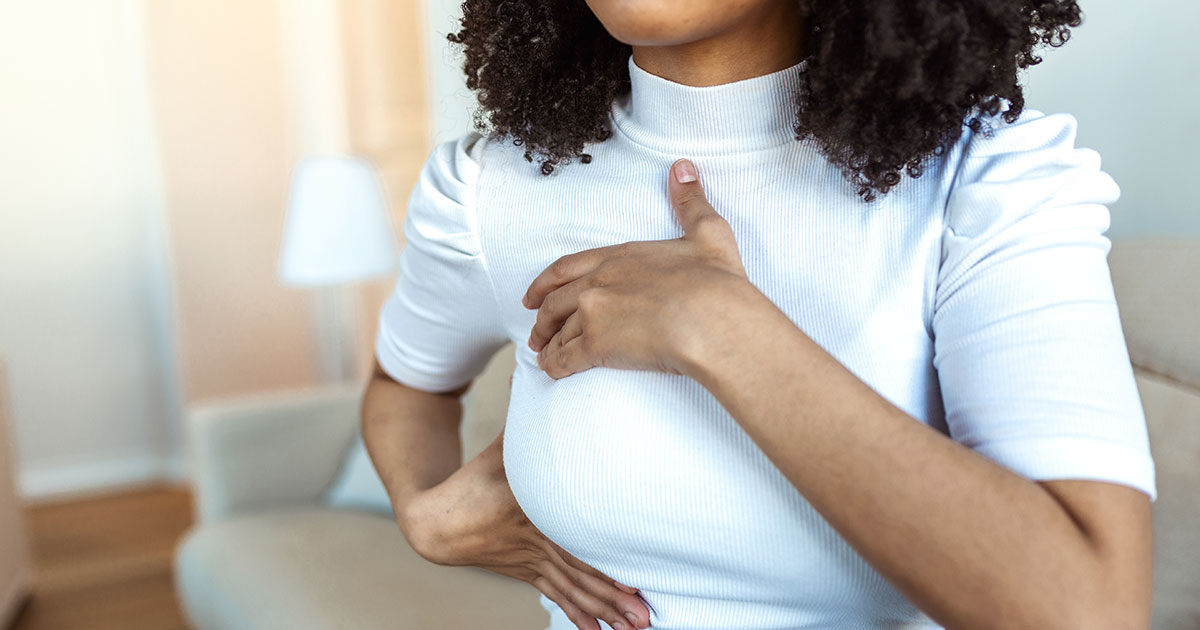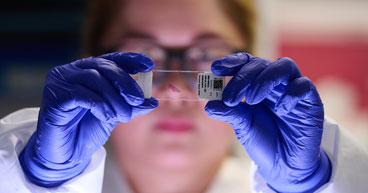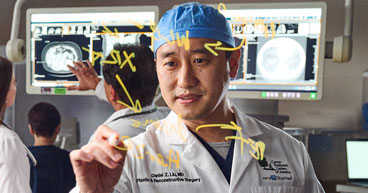
A lump in your breast is always concerning, even if its cause may not be. Because a lump is the most common symptom of breast cancer, it’s easy to jump to the conclusion that the grape-sized mass you suddenly feel in your breast must be a tumor, even though statistics show it’s probably something else.
Still, “If you notice an area of your breast that feels different from the surrounding tissue or corresponding tissue on the opposite breast, that’s a concern,” says Dennis Citrin, MB ChB, PhD, Medical Oncologist at City of Hope Chicago.
A breast mass is typically one of three things, he says:
- Tissue changes related to hormonal fluctuations around the time of a woman’s menstrual cycle
- A benign or non-cancerous tumor
- A malignant or cancerous tumor
“There aren’t a hundred different things it could be,” he says.
In this article, we’ll explore:
- What does normal breast tissue feel like?
- What does a lump in your breast feel like?
- Does breast cancer hurt to touch?
- What to do if you find a lump in your breast
If you’ve been diagnosed with breast cancer and are interested in a second opinion on your diagnosis and treatment plan, call us or chat online with a member of our team.
What does normal breast tissue feel like?
Everyone’s breasts are different. The way they look and feel varies from one person to the next. From floppy to firm and spongy to smooth, there’s no right and wrong.
What’s more, the way your breasts look and feel may change depending on where you are in your menstrual cycle and at different times of your life. Knowing your normal may help you notice changes sooner.
Until about 20 years ago, doctors recommended regular breast exams—performed both by women themselves and by their doctor—to identify potential lumps. However, a study published in 2002 in the Journal of the National Cancer Institute prompted a change in the thinking on breast exams. The study found that exams didn’t reduce breast cancer deaths and actually led many women to undergo unnecessary biopsies and other tests.
The findings prompted a shift in recommendations by medical organizations, including the American Cancer Society (ACS), which now advise women with a low or average risk of breast cancer to simply focus on familiarizing themselves with how their breasts normally look and feel.
The emphasis is on what’s normal for you. It’s time to call a doctor when you notice a sustained difference in your normal.
“Your breasts probably feel differently at different times of the month,” Dr. Citrin says. “Women should know those differences so they can tell whether something changes. The worst thing that could happen is that you may go to the doctor once or twice unnecessarily, but I’d much rather see that happen than have a woman ignore a cancerous mass.”
What does a lump in your breast feel like?
A breast lump feels like a distinct mass that’s more solid than the rest of the breast tissue. Breast lumps feel differently from person to person. And just like women’s breasts look and feel different, so do their tumors. There’s no way to know whether something you feel in your breast is cancer based on its size, shape or texture.
Some may describe a breast lump as feeling similar to an everyday object, like a grape or marble, while others may refer to it as a sort of shelf just beneath the skin. Some breast lumps have smooth edges, and others have rough edges. Some move under the skin, and others don’t.
Although the only way to know for sure if a lump is cancerous is through breast imaging and biopsy, lumps that grow in size, don’t move under the skin, contain small nodules or are bleeding or inflamed need immediate attention from a doctor, Dr. Citrin says.
Does breast cancer hurt to touch?
Most breast cancer lumps don’t cause pain. In fact, if you experience pain or tenderness in the breast, it’s more likely caused by something else, such as hormonal changes. Often, pain caused by something like menstruation goes away. Any pain, tenderness or swelling that persists for more than a few days, though, should be checked out by a doctor, especially if you have a family history of breast cancer.
What to do if you find a lump in your breast
If you discover a lump in your breast, don’t automatically assume it’s cancer. It’s more likely to be caused by something benign. But you should always let your doctor know if you find a lump that doesn’t go away.
Typically, your doctor will ask you questions about the lump, such as when it appeared and whether it’s grown, and, if he or she suspects cancer or simply wants to rule it out, follow-up tests, including a diagnostic mammogram or biopsy, will be ordered.
Finding breast cancer early—when it’s small and hasn’t spread—is one of the best strategies for treating it. That’s why regular screening tests are so important.
The ACS recommends screening guidelines for women at both average and high risk of breast cancer. It considers women to be at average risk if they:
- Have no personal history of breast cancer
- Don’t have a strong family history of breast cancer
- Don’t have genetic mutations that may increase risk, such as BRCA1 or BRCA2 mutations
- Haven’t undergone radiation therapy to the chest before age 30
The ACS considers women to be at high risk if they have:
- A strong family history of breast cancer
- A history of radiation therapy to the chest between the ages of 10 and 30
- A known BRCA1 or BRCA2 mutation or, if they haven’t had genetic testing themselves, a first-degree relative (parent, brother, sister or child) with the mutation
- A genetic syndrome like Li-Fraumeni or Cowden or a first-degree relative with one of these syndromes
For women at average risk, the ACS recommends:
- Optional annual mammograms from ages 40 to 44
- Annual mammograms from ages 45 to 54
- Mammograms annually or every other year from ages 55 and up
For women at high risk, the ACS recommends a breast MRI and a mammogram every year, typically starting at age 30.
If you’re interested in getting screened for cancer or if you’ve been diagnosed with cancer and want a second opinion, call us or chat online with a member of our team.


